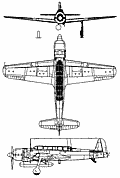|
| Early experience in the Pacific war showing the need for a long-range carrier-based reconnaissance aircraft, Nakajima was instructed in early 1942 to develop an aircraft to meet this Imperial Japanese Navy requirement. It resulted in an airframe similar to that of the company's B6N, the fuselage incorporating camera ports and observation windows, with power provided by a 1358kW Nakajima Homare 11 radial engine. The first prototype flew on 15 May 1943, its performance being disappointing with the Homare 11 engine, and 18 more prototype/pre-series aircraft followed, some with the more powerful Homare 21 engine, before the type was ordered into production in early 1944 as the Navy Carrier Reconnaissance Plane Saiun (Nakajima C6N1). Allocated the Allied codename 'Myrt' when it entered service in the summer of 1944, the Saiun (painted cloud) was fast enough to enjoy almost complete immunity from interception by Allied fighters. A total of 463 had been built' when production ended in August 1945, the total including a small number of C6N1-S two-seat night-fighter conversions from C6N1 aircraft, and one C6N2 prototype with a 1476kW Homare turbocharged engine.

| MODEL | C6N1 |
| CREW | 3 |
| ENGINE | 1 x Nakajima NK9H "Homare-21", 1484kW |
| WEIGHTS |
| Take-off weight | 5260 kg | 11596 lb |
| Empty weight | 2968 kg | 6543 lb |
| DIMENSIONS |
| Wingspan | 12.5 m | 41 ft 0 in |
| Length | 11 m | 36 ft 1 in |
| Height | 3.95 m | 13 ft 12 in |
| Wing area | 25.5 m2 | 274.48 sq ft |
| PERFORMANCE |
| Max. speed | 610 km/h | 379 mph |
| Ceiling | 10740 m | 35250 ft |
| Range w/max.fuel | 5310 km | 3300 miles |
| ARMAMENT | 1 x 7.92mm machine-guns |
 | A three-view drawing (752 x 1113) |
| ubaTaeCJ, e-mail, 21.02.2025 16:52 20 reply | | mike, e-mail, 24.08.2017 04:53 This aircraft proved that the Japanese were able to build outstanding air craft during the war as Nakajima had some of the greatest designs during the war. reply | | rocky, e-mail, 08.08.2017 22:51 I have the one off of moen in my hanger here in the states n there is 1 other but nit is mothballed. this 1 was down below the hospital on moen. I am trying tom find out the history of this myrt anything will help.. reply | | Alan Pipkin, e-mail, 14.02.2015 20:47 When I lived on Moen Island, Cuuk (TRUK) back in the 50's I saw three Nakajima C6N aircraft. Two were located on the Japanese fighter strip at South Beach and one was located a short distance down the hill from the present hospital. They were in good condition and not shot up. reply |
|
| | Klaatu83, e-mail, 22.01.2015 09:08 It is interesting to note that the U.S. Navy never had a dedicated carrier-based reconnaissance aircraft corresponding to this particular airplane. Long-range reconnaissance was always a very important consideration in Japanese naval thinking. The Japanese Admiralty had always planned in terms of weakening the American fleet with submarine, air and destroyer attacks as the American Navy made it's way across the Pacific, and then fighting one final cataclysmic battleship action with what remained of the American Fleet when it finally arrived in the Western Pacific. They always visualized war with the U.S. Navy being somewhat similar to what occurred against the Russian Navy at the Battle of Tsushima in 1905. That was the reason why the Japanese Navy kept most of their largest battleships in home waters during most of World War II. The C6N, the aircraft shown here, was to have played an essential role in the Japanese Navy's overall strategy by keeping track of the position of the U.S. fleet as it made it's way across the Pacific. However, unfortunately for the Japanese, the naval war in the Pacific did not go anything like the way they had anticipated. reply | | deaftom, e-mail, 20.02.2012 05:55 The National Air and Space Museum has a C6N1-S "Myrt" (probably the sole survivor of the type) in storage at its Paul E. Garber facility in Silver Hill, Maryland. This "Myrt" is awaiting eventual transfer, some day, to the restoration facility at NASM's Udvar-Hazy Center near Dulles Airport, Virginia. reply | | wanshan, 21.06.2011 04:45 does anyone know,if anywhere in the world,this famous c6n
saiun could be found in a museum or some other place reply | | bombardier, e-mail, 24.05.2011 19:12 The fastest Japanese night fighter of the war reply | | Ben Beekman, e-mail, 15.03.2011 01:49 The outstanding range listed here is because of the 730 liter external fuel tank shown in the colored side view. Late in the war, with her aircraft carriers all but non-existent, Japan modified some of these aircraft by removing the middle crew member and replacing him with an upward-angled firing cannon to attack B-29's from below. reply | | Bill B., e-mail, 17.01.2011 19:34 Why was the uppr window if the windscreen assembly hinged?
Was it to aid in opening /closing the canopy?? reply | | Tom Ersted, e-mail, 21.12.2010 22:35 I think there was one on display outside at Willow Grove NAS back in the 60's. Don't know what happened after that though. reply | | Mykola, 25.09.2010 10:11 I have nevr heard of a plane with a better range! reply | | Mike, e-mail, 18.03.2010 07:48 THere IS one in a museum somewhere Pierre...I will try to found out for you. I can't help thinking what a great FIGHTER could have been developed from this aircraft...the little bugger sure was fast... reply | | pierre emond, e-mail, 09.02.2010 10:10 does anyone know,if anywhere in the world,this famous c6n
saiun could be found in a museum or some other place ?thanks reply |
|
Do you have any comments?
|
| 
COMPANY
PROFILE
All the World's Rotorcraft
|









20
reply